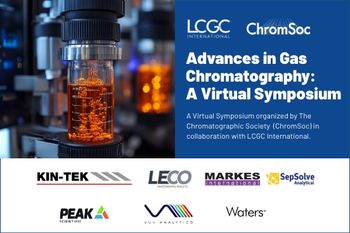
- July/August 2023
- Volume 41
- Issue 7
- Pages: 262–265
Enhancing Extractions by Salting Out

An examination of the principles behind “salting out,” and when it can be applied in analytical extractions to enhance the extraction yield.
Addition of a salt to the sample during the course of an extraction, also known as “salting out,” often quantitatively enhances the extraction yield. In fact, salting out provides the basis for the QuECHERS technique, though it is widely used in other extraction procedures as well. However, the salting out concept is not widely taught, and questions remain, like how much salt to use or which salt should be used. This month, we’ll take a look at the principles behind salting out and offer guidance on the application of this approach in analytical extractions.
The salting out effect is likely one of the least understood, yet widely used, laboratory techniques. It is often not taught in either the undergraduate or graduate curricula and the term “salting out” is used incorrectly in many situations to refer to enhancing solubility. At the most fundamental level, salting in is the process where an increase in ionic strength, through the addition of a soluble salt, increases the solubility of a solute, such as large biomolecules. Salting out refers to the reduction of solute solubility in solutions of very high ionic strength in order to drive the solute into a different phase, such as to enhance liquid-liquid solubility or for protein precipitation. In other words, solute solubility generally shows a slight increase with the addition of salt, but at high salt concentrations, solute solubility decreases rapidly, and solutes can precipitate from aqueous solution or partition into a less polar phase.
Previously in this column, Majors reviewed salting out liquid-liquid extraction over a decade ago with a focus on analytical applications, including drugs in biological fluids, pesticides in fruits and vegetables— and the development of “quick, easy, cheap, effective, rugged, and safe” (QuEChERS)—and heavy metals in aqueous solution (1). He noted that most applications involved the partitioning of polar analytes into an organic solvent (acetonitrile being the most frequently used extractant) with sodium chloride and magnesium sulfate being the most frequently used salts. Systematic studies of the choice of inorganic salt used and its amount seemed to be lacking in many cases, and the general consensus appeared to be that if one adds enough salt, the solute will be driven into the desired phase. Salting out extractions often greatly increase extraction yields from aqueous samples and are functionally easy to perform. Thus, changes to established analytical procedures are minimal. Additionally, the likelihood of emulsion formation is lessened; in fact, addition of salt is one highly touted scheme to break emulsions. Perhaps the biggest drawback of salting out extractions is the presence of residual salt in the organic solvent (or precipitated biomolecule). In addition to driving analytes into a nonpolar phase for liquid-liquid extraction, polar volatile compounds can be partitioned into the sample headspace for subsequent extraction and characterization.
The concept of salting out extraction dates back at least to the German literature around 1890, though there are few systematic studies, especially in the modern (post-World War II) literature, of the technique. One recent review provides a very comprehensive review detailing the mechanisms of salting out and strategies for adopting the technique in chemical processes (2). This paper is highly recommended for those who desire more information on the salting out approach. Let’s take a closer look at the salting out effect for practical use in the method development of analytical extractions.
Mechanism for Salting Out
Salting out is due to the reduced solubility of molecules, especially polar solutes, in a solution of very high ionic strength. The salting out process reduces the molecule’s solubility, leading to precipitation (for example, with large biomolecules like proteins) or driving small molecules into the (less polar) organic phase. This can be explained by understanding the relevant intermolecular forces. In aqueous solution, the water molecules surround the charges of ions or the dipoles of polar solutes. That is, the negative dipole associated with the oxygen atom in a water molecule interacts with the positively charged region of solute ions or molecules. Simultaneously, water’s positive dipole is attracted to solute regions of negative charge. As soluble salts are added to aqueous solution, ionic strength increases, and eventually, the water molecules are less able to support the dissolution of other solutes via these dipole-dipole or hydrogen bonding intermolecular attractions. Figure 1 graphically depicts this process as a continuum from salting in to dissolution to salting out. Of course, this is a dynamic process, meaning that the solvent-solute interactions are continually formed and broken and, as salt concentration increases, both the number and frequency of these interactions increase. Addition of hard anions (that is, those with high charge density) act through a combination of electron repulsive forces and enhancement of the hydrophobic effect causing solute aggregation to some degree of order.
Thus, salting out is dependent on ionic strength, which is a function of the concentration of ions and the ionic charge. When multiple ions are in solution, the total ionic strength is the sum of the ionic strength of all of the ions. This is described by the Debye-Huckel limiting law which, at high salt concentration, defines solubility via the expression:
(sometimes referred to as the Setschenow equation), where S is the solubility, S0 is the solubility in pure solvent, B is a constant that is a function of solute concentration, charge, pH, and temperature, K is the salting out constant dependent on pH, mixing, and salt composition, and I is the ionic strength of the salt. This equation holds for solutions with salt concentrations up to about 0.1 M. For more concentrated additions of salt, more rigorous treatments are required.
Salt Selection and the Hofmeister Series
Selection of salt to be used for salting out extractions is somewhat empirical. Of course, parameters such as human and environmental health considerations, waste, cost, corrosivity, availability, and other factors are all important. From the green perspective, organic salts would be preferred and small molecular weight, multiply charged salts are more effective. We can also observe which inorganic salts are more likely to induce the salting out phenomenon at lower concentrations. It has become generally accepted that in most cases, the anion exhibits a greater salting out effect than the cation. The resulting Hofmeister series is shown in Figure 2, listing the relative ability of various ions to participate in the salting out process; that is, from most (left) to least (right) precipitating. In this figure, kosmotropic (order-making) salts are at the left of the graph and promote salting out. After about Cl- , the ions listed are chaotropes (chaos forming) and are more likely to result in salting in. Note that in this series, the effect of anions and cations are not shown relative to each other. Because the salting out effect is less for cations compared with anions, some differences in the Hofmeister series for cations is observed with protein precipitation compared with salting out of small molecules.
From the perspective of the target analyte, salting out tends to be more effective with solutes which have high polarizability, large molecular volume, and lower polarity. Another consideration during method development is that, in multiresidue procedures, not all solutes will be affected by addition of salts to the same degree.
Analytical Applications of Salting Out Extractions
The development of the original QuEChERS multiresidue extraction method for pesticides in produce is based on a salting out process followed by dispersive solid-phase extraction (4). Because the original method was intended to screen for hundreds of potential pesticide residues in dozens of fruits and vegetables, a general, yet effective, salt was used, in this case a combination of magnesium sulfate and sodium citrate salts at a ratio of approximately 2:2:1 sample:acetonitrile:salt. As QuEChERS has become commercialized with vendors creating salt kits for specific applications like fatty samples, highly pigmented samples, or other analyte classes, different salts and salt amounts are seeing use. In addition to the extraction of drugs in biological fluids and separation of heavy metal ions from aqueous solution presented by Majors, a quick search of the scientific literature uncovers a growing number of applications like the purification of diols from fermentation broths, extraction of additives from plastics, isolation of plant-based hormones, extraction of immunoglobulins from egg yolk, and the characterization of collagen in fish tissue (1).
Conclusions
Salting out can be a rapid, effective, and relatively painless means for enhancing the extraction of polar analytes from aqueous samples. While the technique has seen broad use, general practitioners have little experience in developing salting out methods. Use of tools like the Hofmeister series can guide creation of enhanced extractions using the salting out principle. Recent applications, including development of the QuEChERS technique, and a drive toward greener procedures, will lead the increasing use of salting out in analytical extractions.
References
(1) Majors, R. E. Salting-out Liquid-Liquid Extraction (SALLE). LCGC N.A. 2009, 27, 526–533.
(2) Hyde, A. M.; Zultanski, S. L.; Waldman, J. H.; Zhong, Y.-L.; Shevlin, M.; Peng, F. General Principles and Strategies for Salting-Out Informed by the Hofmeister Series. Org. Proc. Res. Dev. 2017, 21, 1355–1370. DOI:
(3) Salting out. Wikipedia.
(4) Anastassiades, M.; Lehotay, S. J.; Stainbaher, D.; Schenck, F. J. Fast and Easy Multiresidue Method Employing Acetonitrile Extraction/Partitioning and “Dispersive Solid-Phase Extraction” for the Determination of Pesticide Residues in Produce. J. AOAC Intl. 2003, 86, 412–431. DOI:
About the Column Editor
Articles in this issue
over 2 years ago
Strongly Adsorbing Analytes: What, Why, and How to Fix Itover 2 years ago
Basic Care and Feeding of Your Detectorover 2 years ago
A Modern Mineral Oil Hydrocarbon Analysisover 2 years ago
Is There a Paradigm Shift in Industrial Scientific Careers?Newsletter
Join the global community of analytical scientists who trust LCGC for insights on the latest techniques, trends, and expert solutions in chromatography.





